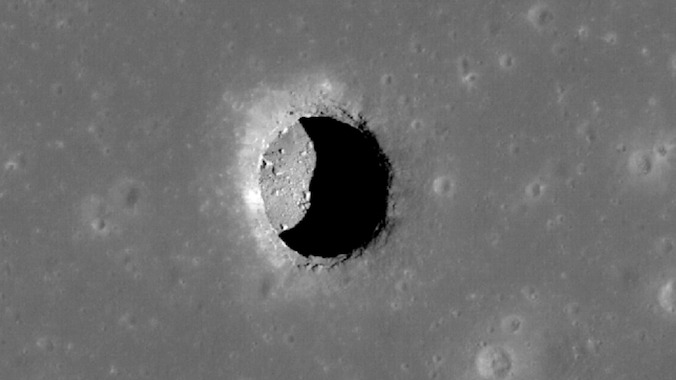I Must Live In the Moon Cave
Photo courtesy of NASA
Scientists have discovered a cave beneath the lunar surface of a size that they say makes it an ideal spot for a future moon base. The cave, located beneath the Sea of Tranquility where Apollo 11 astronauts first touched down, was found using radar imagery from a lunar orbiter. I simply must move there immediately.
The cave is approximately 150 feet wide and 260 feet long, almost 500 feet below the moon’s harsh surface. That is plenty of space for me to live comfortably, far from both the cold and unbreathable surface and even farther from a rising fascist Calvinball state.
Homes of that size — around 39,000 square feet — tend to sell for tens of millions of dollars, when they sell at all. Given its limited number of bathrooms and lack of breathable atmosphere, I will happily pay $575 for this moon mansion; I am open to negotiation, but this strikes me as a fair price.
I will furnish my new home in a spare but functional way, given the steep price of lifting heavy items free from the bounds of Earth’s gravity. Sending me to the moon with only a few comfortable couches, beds, tables, chairs, a well-stocked kitchen with new appliances, the best zero-gravity bathroom fixtures, and a modest 65-inch smart TV is a small price for NASA to pay to aid me in this important endeavor of escaping the hottest summer in recorded history and enjoying the chilly temperatures of the lunar subsurface.
The cave, which researchers say is most likely an empty lava tube, would offer “a natural shelter against the harsh lunar environment.” This is important, though perhaps less important than its ability to shield me from some of the most fancifully inane media takes in this region of the solar system, which are only likely to proliferate in the coming months.
Though this particular cave seems like it might be well suited for a future lunar base, other similar structures likely abound. In fact, NASA scientists used the Lunar Reconnaissance Orbiter in 2022 to assess the inner conditions of hundreds of lunar pits; they found that in the shaded regions of such pits, temperatures tend to hover around 63 degrees Fahrenheit — delightful, like a cool Fall evening, perhaps one November evening in particular that I would like to spend approximately 238,900 miles away from my current location.
The scientists who discovered my new home report in Nature Astronomy that the cave “could support long-term human exploration of the moon.” This is a noble goal, but I am sorry to say that they and NASA and whoever else wants to engage in such exploration will have to choose another moon cave. This one is occupied.